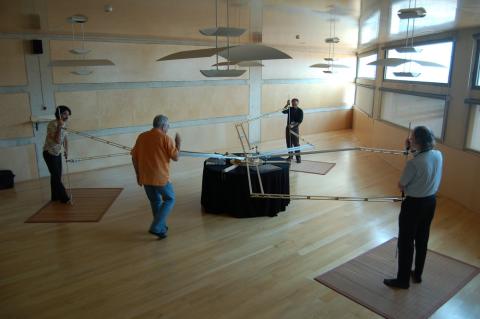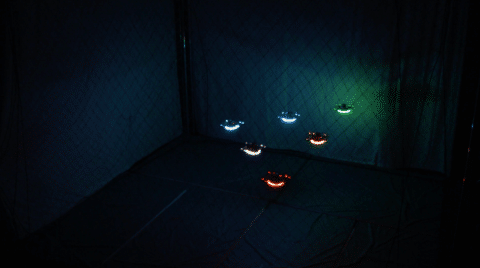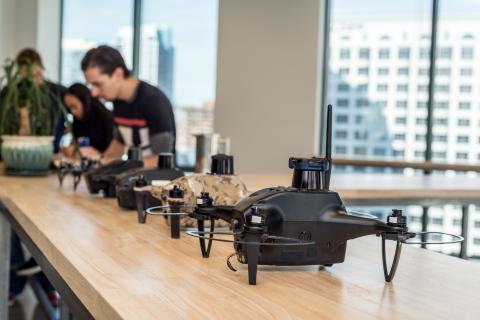[August 23, 2018]
Why Shield AI: The Complexities of Human-Machine Interaction

A conversation with Ali Momeni, Senior Principal Scientist and Director of User Services & Experience at Shield AI
Prior to Shield AI your work was in creative arts. What project are you most proud of? What was it and why?

“Tragedy of the Commons” by Ali Momeni and Robin Meier, Photo by Aurélie Cenno
I worked on a series of interactive installations called The Sisters, that consisted of collaborations between myself, my long time art-partner Robin Meier, and groups of insects — namely social insects. Each began with an exploration of a well-understood observation of an aspect of the insect’s life, as discovered and described by scientists. For instance, Gabriela Gibson et al discovered that mosquitoes listen to one another and match pitch, by aligning their wing-flapping frequency with one another to fly in harmony and mate mid-air. This led us to collaborate with an entomology lab at the University of Minnesota, where I used to teach, to learn how to create Truce — a restaging of this behavior in a controlled and dramatized setting, to effectively exhibit a choir of living mosquitos that sang in tune. Similarly, we worked with ant experts to create a Tragedy of the Commons, a theatrical setting for observing the incredible collaborative foraging and architectural skills of atta sexdens (“leafcutter ants”); and If the Lion Could Speak — an exploration of the innumerable super-powers of honey bees.
What attracted you to make the shift to Shield AI?
I have always been drawn to the complexities of human- and animal-machine interactions. From kinetic sculptures and multi-media installations, interactive visual and musical performance instruments that I have invented and performed with, to creative educational tools that we designed and built in my laboratory at Carnegie Mellon University… I’ve always been drawn to designing systems and interactions that draw upon the nuances of communication, from sound, and image, to gesture and words. The fundamental problems of human-robot-interaction that come to the fore as we begin to develop planetary scale, collaborative, resilient intelligent robotics are fill with these nuances. The opportunity to work with an extremely talented and forward-thinking team like that at Shield AI, starting with my esteemed colleague Nathan Michael who extended the initial invitation to me, was one that I did not want to not miss.

“Shahnameh Remix” by Ali Momeni and CMU RISL
What are you most excited for in Shield AI’s future?
I’m excited about the long horizon of technological possibilities, and the wide range of human-interaction use-cases where we can make positive impact with our inventions. From protecting the lives of civilians and service members, to enhancing humanitarian and first responder efforts in situations ranging from natural and unnatural disasters, and beyond. I see tremendous potential for our approach to scalable autonomy and intelligence to better our lives.
You lead our user services and experiences group – Why is this such an important function at Shield AI?
Shield AI is a mission-driven company, and our mission is about protecting and helping people. Obviously, our work is highly technical and tremendous rigor goes into software and hardware engineering, security, mechanical ingenuity, data management, etc. But our products only deliver the value they promise if people are positively impacted; and this can only result from people successfully using our systems. Service and Experience design is therefore paramount to the success of all that we do at Shield AI.

“Frelia” by Ali Momeni and Robin Mandel
How do you describe your design philosophy / your approach to design?
“Human Centered Design”, the approach to design that’s now widely celebrated across academia and industry, is an excellent starting point. In light of the complexities of our products and vision, it is critical that we maintain a human-centered approach to autonomy and artificial intelligence, and consider first and foremost how these tools interact with and improve our lives. Beyond that, an explicit recognition of the unknown and uncharted nature of the work is a very key guiding light for me. Taking on the responsibility to push the state of the art, and accepting the challenge to do so with rigor, craft, and humility are my mottos.
What design rules do you swear by?
I draw from a wide range of influences and guidelines. Popular ones include “Understand before you try to be understood” (observe users and use-cases before proposing solutions); “Eat your own dog food” (use the tools you build for others within your own team); “Don’t make me think about it” (the value of user interfaces which do not require explanation or reflection); just to name a few. Beyond these helpful guideposts, I also swear by more foundational principles: Respect and kindness for all others; Celebration of diversity in gender/ethnicity/culture/etc.; Deep belief in the value of interdisciplinary thinking and working.









